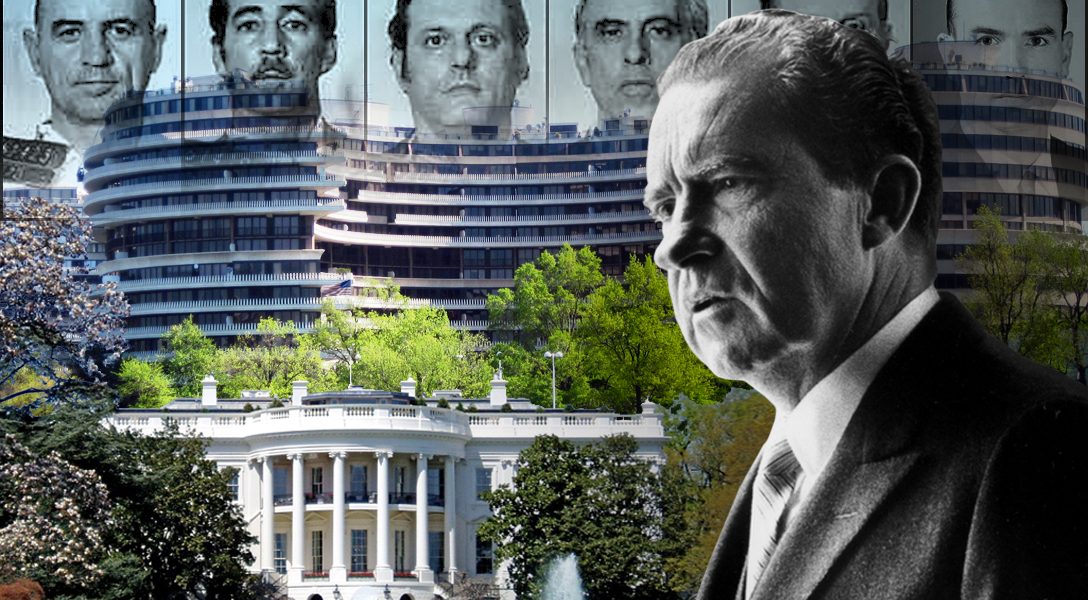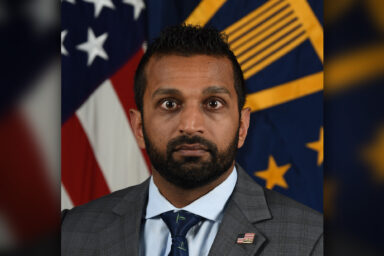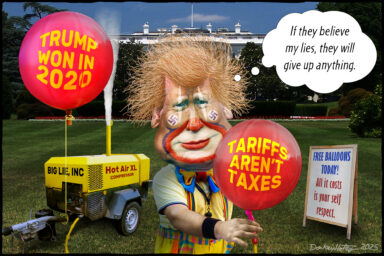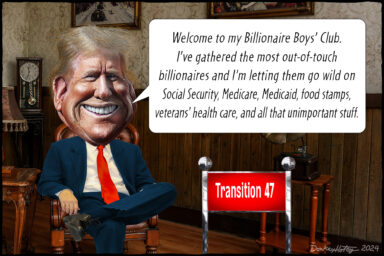Shane O’Sullivan draws on newly released records to talk about the many gaps in the story of Watergate.
With the news cycle of late nearly engulfed by the questions — and spy games — swirling around “Russiagate,” taking a fresh look at Watergate could be an especially worthwhile endeavor. Luckily, revisiting the rise and fall of President Richard Nixon is exactly what Shane O’Sullivan does for us in his new book, Dirty Tricks: Nixon, Watergate and the CIA.
O’Sullivan — Jeff Schechtman’s guest in this week’s WhoWhatWhy podcast, and an author/filmmaker whose previous work has dug into the Kennedy assassinations — takes us beyond the popular Woodward-and-Bernstein Hollywood scenario, revealing instead the deepest workings of Nixon’s cronies. From the Anna Chennault affair and the Ellsberg break-in to Watergate and the CIA, the author provides new information in a number of areas.
O’Sullivan examines what President Lyndon B. Johnson and the CIA knew about then-GOP nominee Nixon’s back channel to Chennault — allegedly used in order to scuttle the Paris peace talks and thereby gain an advantage in the final days before the 1968 election — and why they did nothing about it.
He examines the distinction between what the CIA as an agency may have known, and what individual CIA operatives knew. He probes the deep relationship between Howard Hunt and CIA Director Richard Helms. And he seeks to further understand the role — and the missteps — of James McCord, and his possible role in a possible hidden CIA agenda.
Click HERE to Download Mp3
Full Text Transcript:
As a service to our readers, we provide transcripts with our podcasts. We try to ensure that these transcripts do not include errors. However, due to time constraints, we are not always able to proofread them as closely as we would like. Should you spot any errors, we’d be grateful if you would notify us.
| Jeff Schechtman: | Welcome to Radio WhoWhatWhy. I’m Jeff Schechtman. In the current vortex, Trump and Russia, the invocation of the CIA, the FBI, current and former members of the intelligence and law enforcement community, and references to Watergate seem on some days to account for at least half or more of all the coverage and discussion. |
| Given that, going back to look at Watergate, Nixon and his ’68 and ’72 campaigns, and his own ragtag team of henchmen, seems like the right thing to do. And don’t forget Roger Stone, who seems to be part of the gang that couldn’t shoot straight, in both stories. | |
| This is the look back, taken by our guest Shane O’Sullivan in his new work Dirty Tricks: Nixon, Watergate, and the CIA. Shane O’Sullivan is an author and filmmaker based in London. His work includes the acclaimed documentaries RFK Must Die, Children of the Revolution, and Killing Oswald, as well as the book Who Killed Bobby? | |
| He holds a Ph.D. in film from O’Hampton University and is a senior lecturer in filmmaking at Kingston School of Art in London. It is my pleasure to welcome Shane O’Sullivan back to Radio WhoWhatWhy, to look at his new work, Dirty Tricks: Nixon, Watergate, and the CIA. Shane, thanks so much for joining us. | |
| Shane O’Sullivan: | It’s a pleasure. |
| Jeff Schechtman: | One of the things that you do in looking at Nixon and Watergate and the dirty tricks is first you go back really to the ’68 campaign, to the Vietnam peace talks that were percolating at the time, and to a woman named Anna Chennault. Talk a little bit about that, as kind of the preface, really, to the Watergate story. |
| Shane O’Sullivan: | Yeah. Anna Chennault’s been kind of a footnote from my research into the Bobby Kennedy assassination, because she’s actually referenced by a witness to this potential girl in the polka-dot dress in that story. And I chased that lead up, and I actually met her at her Watergate penthouse apartment a couple of years before she died. |
| She’s a fascinating figure. I mean, basically in the ’68 campaign, she was very close to a lot of the southeast Asian governments, and close particularly to the South Vietnamese government. And knew the South Vietnamese ambassador in Washington. | |
| So she used that leverage to become the conduit between the Nixon campaign and the South Vietnamese ambassador in Washington, to try and stop [inaudible] scheduled to happen on November the 6th, which is the day after the election. | |
| And if they had confirmed that they were going to come to them, from Saigon, that would’ve given the Democrats a kind of a fillip in the last days of electioneering. And Hubert Humphrey was kind of catching up quickly on Nixon in the polls. And it may have given him just the extra fillip or the extra spurt of votes in the final days of the campaign, to beat Nixon and deny him his second shot at the presidency after he’d been narrowly beaten by Kennedy in 1960. | |
| Jeff Schechtman: | And what was the conduit? What was the way in which Chennault and Nixon were able to communicate what was going on behind the scenes? |
| Shane O’Sullivan: | Well, she would have regular meetings with the South Vietnamese ambassador. But she also brokered a very early meeting between the South Vietnamese ambassador, Bui Diem, and Nixon himself in Nixon’s apartment in New York, in July 1968. |
| That was obviously kept top secret, and nobody was supposed to know about it. A lot of the close figures around Nixon denied it ever happened. But finally, in memoirs, in 1980 and 1987, Anna Chennault and Bui Diem themselves confirmed that the meeting did happen. | |
| So, I find that in the book that the kind of early idea of being this conduit within the Nixon campaign, and Bui Diem, and him obviously having a line to the South Vietnamese government in Saigon. | |
| That began happening as early as February the 16th, in 1968, when Anna Chennault met John Mitchell, who was Nixon’s campaign chief for the first time. She met him in that same New York apartment. Also present was Rose Mary Woods, Nixon’s secretary, and a few other leading figures in the Nixon campaign at that time. | |
| So from that point onward, she began to offer her participation as a means of getting messages back and forth between the Nixon campaign and the South Vietnamese government. And, obviously, as election day neared, she became crucial to holding the pack together, and reassuring South Vietnamese government that as they waited for a Nixon presidency, they’d get a far better deal. And they’d be in a far better place in terms of support in the ongoing war, and supporting the government than if they cooperated with the Hubert Humphrey campaign instead. | |
| Jeff Schechtman: | And what did the US government, the CIA, and even Johnson know about what was transpiring here? |
| Shane O’Sullivan: | Well, the CIA and the NSA had intercepts going in, in some of the offices in Saigon. So they were hearing what the South Vietnamese government were hearing from Washington. Also, in the dying days of the campaign, LBJ began to hear rumors of what was happening as well. And he got the FBI to install telephone surveillance on the South Vietnamese Embassy. He also got physical surveillance started on Chennault herself. |
| FBI teams would watch her go back and forth to the South Vietnamese Embassy. They also overheard a key call that she made on the Saturday before the election, in which she passed on a message from her boss, that Saigon was to hold on, we’re gonna win. | |
| And that basically, the pact that had been set up and the gentleman’s agreement not to go to Paris, and to hold out for a Nixon presidency. They were going to hold to that agreement. And truly, that’s what happened. | |
| LBJ announced a bombing halt at the end of October. He thought the South Vietnamese were on their way to Paris on November 6th. The election was November 5th. He thought he had all his ducks in a row, and Hubert Humphrey was fast gaining in the polls, was going to get there, and he was going to beat Nixon. | |
| But then the South Vietnamese suddenly said “No, we’re not going to do Paris. We’re going to go there on our own terms.” And the intervention of Anna Chennault, which had been developed with Bui Diem and the Nixon campaign over the preceding months, finally won out and it gave Nixon the presidency in ’68, and really set up the Nixon era. And then Watergate was the next chapter of that. | |
| Jeff Schechtman: | It’s also interesting, that even though the CIA and Johnson really at a certain point knew what was transpiring, or had a pretty good idea of what was transpiring, they never went public with it. |
| Shane O’Sullivan: | No, and this was a point of heated debate between Johnson and some of his key advisors, his National Security Advisor Walt Rostow, and Secretary of State Clark Clifford, and then a number of other figures. |
| And they just felt at the time that, “Okay, we have this intelligence from CIA and NSA and FBI [inaudible] et cetera, but if you begin to inject that kind of national security material and make it public during the election campaign, it’s simply not done. And it’s not good for good good governance and good, kind of, etiquette in terms of the politics at the time. | |
| So I guess they took the high moral ground in terms of using it in the dying days of the campaign, and I think Hugh Humphrey took a similar approach to it. So they essentially knew what was happening, but felt their hands were tied, and they couldn’t make it public because of the sources and methods that were used to gain this intelligence. | |
| And Nixon continuously denied it. He said he was at arm’s length from Chennault. It was essentially kind of a rogue operation. Richard Allen, who was the foreign policy advisor to Nixon, who’d actually been in touch with Chennault all the way along, he denied it. He continued to deny it. Even in his later years in [inaudible] of history, he gave in 2002. | |
| But what I think my book does with Allen in particular is to go back and to look at their statements and see if they just don’t line up with what’s in his personal papers, and some of the documents recording his correspondence and calls with Anna Chennault in the key moments of that election campaign. | |
| Jeff Schechtman: | It is interesting to look at the parallels to the 2016 campaign, and what the Obama administration knew before the election with respect to Russian interference, and not going public with that information. |
| Shane O’Sullivan: | Yeah, there are certain similarities. I guess with the book, there are so many resonances and so many parallels you could make to the, either to the 2016 election, or events in Washington now. But I think it’s so fast changing, and our understanding of what happened in 2016 is so fast changing, I thought there was a danger of dating the book if what I write today will be out of date tomorrow, because things are changing almost daily in the news cycle. |
| So I think reading the book, you’ll make a lot of connections with what’s happening now, and what’s happened in the most recent election. But I try to keep it separate in the writing itself. | |
| Jeff Schechtman: | Talk about why the story about the Vietnam peace talks and Chennault and Nixon, why that was an important part of this story, as you lead up to what you write about primarily with respect to Watergate. |
| Shane O’Sullivan: | Obviously, you’re leading on to my previous work. LBJ had decided not to run once Bobby Kennedy entered the race. LBJ had decided not to run himself for a year in ’68. Then Bobby was assassinated. Then Anna Chennault’s role in getting Nixon elected is of great personal interest to me following that narrative through. |
| And then I think the part of the lesson of the Anna Chennault affair was there was because these underhanded tactics were used, and quite brazenly used, and LBJ knew about it at the time. | |
| Nixon got away with this. And so that the dirty tricks that were used in the 1972 election, when arguably he didn’t need dirty tricks, because he was more of a hot favor. It didn’t look like the election was going to be anywhere near as close as it was in ’68. | |
| They became much more ambitious with their dirty tricks program, and the kind of oppositional research. And they employed fairly reckless figures to carry it out. People like Gordon Liddy, who came up with these kind of harebrained schemes that really, with a lot of the mistakes that were later made, instantly pointed the finger as to who was responsible. | |
| I mean, the figure of James McCord, if you put James McCord on a break-in team going into the Watergate offices of the DNC, and if he’s caught in there on their second attempt on June 17, 1972, and they identify him as James McCord, they’re going to see he was the head of security for the Committee to Re-Elect the President. | |
| So he instantly links the burglary team with the opposition. I think when Jeb Magruder who was in California, heard the news that McCord was one of the five who’d been caught in the offices, he just couldn’t believe it. He couldn’t believe that Gordon Liddy had been so reckless in terms of putting somebody who could directly link the burglars to CREEP on that team. | |
| So it’s fascinating to look into that kind of hubris and the overambitious plans they had that eventually led to Nixon’s downfall, with his resignation in ’74. | |
| Jeff Schechtman: | And the Watergate story really begins with the break-in of Daniel Ellsberg’s psychiatrist’s office in California, which is really the first time Liddy and Hunt are brought in to begin this process for Nixon. Talk about that. |
| Shane O’Sullivan: | June ’71 was actually the publication of the Pentagon Papers, and through the whistleblower Daniel Ellsberg, who’d been an analyst at the Pentagon. And so Nixon’s response, he was infuriated at all the acclaim this liberal gun, Daniel Ellsberg, was receiving for his brave act of leaking these documents. |
| And so he brought Hunt and Liddy into the White House team to look into the leaks that were going on. And also in Hunt’s case, to try and assassinate Ellsberg’s character in the press, to destroy his image through two things: one, constructing a psychological profile with the CIA attempting to look at his character and what the weaknesses of his character were, in terms of targeting these in the press and also going more directly to the files of his psychiatrist. | |
| Daniel Ellsberg had been seeing a psychiatrist in Beverly Hills from ’68 to 1970 and they thought, “The FBI records we have on Ellsberg don’t give us very much to go on. Why don’t we break into his psychiatrist’s office and try to get his medical file?” | |
| So in terms of planning that break-in, Hunt and Liddy went to California. And they took various casing photographs of the office where the psychiatrist was, in which Hunt takes the photographs with a camera on loan from the CIA. And they picture Liddy lighting a pipe in the parking lot outside the target building. | |
| Hunt then gets these photographs developed by the CIA. So the CIA has copies of the photographs of the casing operation that they’re doing outside Ellsberg’s psychiatrist’s office. Yet later, they deny knowing anything about what Hunt and Liddy were up to for the White House. Not having asked what the materials that they provided to Hunt and Liddy were going to be used for. And so on and so forth. | |
| These photographs of the casing operation before the Ellsberg break-in later became a key to the unraveling of the Watergate cover-up, because the CIA had copies of the photographs, but claimed they didn’t know what they represented. They then were given to the Justice Department, who again, later claimed they didn’t know what they represented. | |
| But John Dean knew all along that the Justice Department had these photographs. And sooner or later any prosecutor worth his salt was going to figure out what they were. Basically given the infamous nature of Daniel Ellsberg, and they realized that Hunt and Liddy were involved with that. | |
| They put two and two together, and later find out the importance of these photographs. So they become a key part of the Watergate story, in terms of how it all came out between the separate Watergate trials, and also the trial of the Ellsberg break-in as well, in California, in ’73. | |
| Jeff Schechtman: | Is there a distinction to be made by the involvement of the CIA as an institution versus the involvement of many individuals inside the CIA specifically? |
| Shane O’Sullivan: | Well, I think this was a key aim of the book, was to try and unravel a lot of this stuff in terms of who knew what when, and the famed compartmentalization of information within the CIA. And the feeling, for instance, about this photograph, which seems to show what Hunt and Liddy were up to in late August of ’71, before that Ellsberg break-in happened. |
| Also, the associations of the Watergate burglars themselves. Because when you look at the five who are arrested on June 17, 1972, Rolando Martinez was still on a retainer with the agency of $100 a month to keep an eye on Cubans coming into Miami for the agency. He’d been a kind of, almost a hero of 300 infiltration missions into Cuba in the early ’60s, for the CIA. And some of them smuggling sniper rifles into Cuba to try and assassinate Castro. | |
| So he was very loyal to the agency and he was still on their books. They had wound down those infiltration raids in the late ’60s, but he was still kept on a retainer. And he was still in awe of Eduardo, which is the nickname they called Howard Hunt, because Howard Hunt had been a heroic figure in the CIA for the Cubans in Miami in 1961, around the time of the Bay of Pigs invasion. | |
| When Hunt came down on the 10th anniversary of the Bay of Pigs in 1971, and asked Bernard Barker and Rolando Martinez if they’d like to begin working with him again on the national security operation for the White House they pledged allegiance to Hunt, allegiance to the country, and said, “Sure.” | |
| Apparently, later on, a couple of months later, Ellsberg supposedly had given a copy of the Pentagon Papers to the Soviet Embassy. So, citing the national security nature of the operation, they were happy to get involved. | |
| So basically, Barker and Martinez and a number of the Cubans who were involved in these operations were doing it out of loyalty to Hunt, loyalty to the agency, even though Hunt was no longer working for the agency, and was working with borrowed CIA equipment. | |
| So Hunt was working for the White House, and using some of the CIA equipment. The CIA said, “Well, he was working for Nixon, he had nothing to do with us at that time.” But I think the book goes into the nature of Hunt’s relationship with Richard Helms, the nature of his continuing friendship with a number of figures within the CIA, which kind of goes against that. | |
| The relationship with Helms was particularly interesting because Hunt, in his spare time, had been writing spy novels with the intention of becoming something of an American Ian Fleming, constructing a kind of American version of James Bond. | |
| It turns out, when you look at some of the documents around that project, it was a very closely held project that was partly the brainchild of Richard Helms and Thomas Karamessines at top of the agency, with the aim of creating a more positive image of the agency through spy novels and potentially their adaptations as Hollywood movies. | |
| In May 1972, for instance, there was a screening of The Godfather, which is attended by Richard Helms and the head of the Motion Picture Association of America. And two weeks before the first Watergate break-in, Richard Helms was there, pitching Hollywood studio heads with the spy novels of Howard Hunt. Two weeks before Hunt commands a team that’s going to do the first Watergate break-in. | |
| Their relation was much closer than Helms acknowledged in his later testimony. And part of the book is looking at the nuances of that in terms of did Helms have full knowledge of the operation? And what did he know after Watergate, and what did he cover up? | |
| In a sense, a lot of the book is saying, “What did Helms and what did the CIA, certain CIA figures know, and when did they know it?” | |
| Jeff Schechtman: | And where does James McCord enter the picture? |
| Shane O’Sullivan: | James McCord had been the head of physical security for the CIA in the late ’60s, in charge of the security of CIA installations. That got him caught up in Operation CHAOS, and a lot of these very controversial CIA schemes targeting domestic dissidents and anti-war protesters. And he took that kind of siege mentality with him to the Committee to Re-Elect the President when he was made its head of security towards the end of ’71. |
| He had quite right-wing political views. He, like many others, thought there was a possibility that Cuban money was being used to support the McGovern campaign. McGovern would later be confirmed as the Democratic presidential candidate in ’72 election. | |
| So part of the reason he was going to the DNC was to find out what kind of support there was from Cuba in terms of documentary evidence. But that the Cubans were financing McGovern, but also personally McCord had some information that Vietnam Veterans Against the War were actually operating from within the DNC as well. And threatened to disrupt the Republican convention in Miami later that summer. So that was part of his motivation for going in there. | |
| But in terms of his expertise, he was the guy in charge of the bugging. So in terms of the Watergate break-ins, we had two different aspects to it. Hunt’s mission for Barker and Martinez and some of the other Cubans was to go and then find these documents, which would prove there was Cuban money flowing into the McGovern campaign. And that could obviously be used for political purposes to kill off any threat from McGovern in the election. | |
| But on McCord’s side, he was all about the bugging. And supposedly, he was trying to plant a bug on the phone of Larry O’Brien, who was the chairman of the DNC at the time. But when you look into it, on that first break-in, McCord didn’t have a floor plan of the DNC. And didn’t actually know where Larry O’Brien’s office was. So he ended up planting a bug in the wrong office in the phone of the secretary next to the head of communications on the other side of the building from where Larry O’Brien’s office was. | |
| That mistake was part of the reason why then the burglars had to go in a second time, and why they were caught. And on the second break-in, again, it was McCord’s fault because they tried to get in the first time, and had failed, and then the second time, they left tape on the basement door. | |
| McCord was following them up onto the sixth floor of the DNC. He didn’t remove the tape when he let himself in, and it was found by the guard who then called the police. | |
| So McCord is a very curious figure, because he made a number of elementary errors throughout a number of the break-ins, in either in terms of preparation or what he did on the night. He went missing at certain times. He put himself aside from the rest of the team, leading to some of the other Watergate [inaudible 00:23:19], feeling that he’d walked them into a trap. | |
| They felt something wasn’t right about the operation. The briefing was very haphazard. There were a number of mistakes made by Hunt and McCord that just didn’t ring true. And certain figures like Martinez, in later years, felt that McCord had walked them into what had been a setup. That also applies to Martinez thinking about the Ellsberg break-in. He also thought that was a setup. So I dive into a number of these break-ins in the book. | |
| Jeff Schechtman: | Talk about what some of the theories are as to why McCord might have made these mistakes, these really elementary mistakes. |
| Shane O’Sullivan: | Well, looking at them, I think some of the mistakes were just basic errors that came perhaps because of the pressure they were under at the time to produce results. But you also have to look at the different agendas each of the burglars had. There’s also theories about that. |
| McCord was also a member of the Air Force Reserve at the time. He was connected to a number of right-wing figures. He was looking at the potential threat at the Republican convention in ’72 from the Vietnam Veterans Against the War. So there was an element of him being a hitchhiker on the second break-in where he was along for the ride, but for different reasons. And he was also still very close to the CIA. And still very close to senior figures there. | |
| Then you had Hunt, who was tied into the Robert Mullen Company. Who, again, they were a public relations firm. But it wasn’t known at the time that they were also providing cover for CIA agents in Europe. And they were also the representative for the Howard Hughes Organization. | |
| And vying with Howard Hunt to be the Washington representative of the Howard Hughes Organization, was a guy called Robert Oliver. Whose son, Spencer Oliver, was the DNC official whose phone was bugged. And during the first Watergate break-in and his conversations were intercepted by Huff and Baldwin in the motel across the street, the Howard Johnson, for three weeks leading up to the second Watergate break-in. | |
| There’s a theory that Hunt may have been motivated by a struggle for power with Oliver Senior. And basically wanting to blackmail Spencer Oliver through the material that was developed through these intercepted conversations. There’s a number of different agendas competing here, in terms of our understanding of what was going on. | |
| Jeff Schechtman: | And with respect to those competing agendas, one of the results that it has had is that it’s made it very difficult over the years to try and define or determine the singular motivation for the break-ins. |
| Shane O’Sullivan: | Yeah. I mean, it still is a mystery, because really, there was no important information developed. But I think the key, in terms of political information, according to the conventional wisdom of the previous books on the case … But I think I was one of the first authors, actually, to speak to Spencer Oliver, who is the DNC official whose phone was actually bugged at the time. |
| And he went on to a number of really high-profile jobs overseas, and tied in with national security. It’s only recently that when he’s retired, he’s begun to read the books about Watergate, and finally consented to grant an interview. | |
| So he gave me a very interesting new take on what information was gleaned from those phone calls, and why it was of use to the Republican campaign at the time. He said that he was leading a campaign within the DNC to stop McGovern at all costs, because he felt that McGovern was a left-wing candidate who was just the candidate that Nixon wanted. Because he was so left wing, he was basically unelectable. And he would be the easiest candidate for Nixon to face. So, the Nixon campaign was all about ensuring that McGovern was the candidate that they were going to face, because it was going to be a walk in the park for them. | |
| Whereas within the DNC, Spencer Oliver was supposed to represent the Association of State Democratic Chairmen. He was supposed to be impartial and represent chairmen from all over the country. But actually, secretly, on that phone in his office, he was trying to mount a Stop McGovern campaign. | |
| So part of the political intelligence that was being gathered through intercepting his phone, was figuring out what was going on inside the DNC to subvert McGovern, to stop him, and to try and foil his bid. And then obviously, the Nixon campaign could try and counter that to ensure that he was nominated as the Democratic candidate. And in the end, there was a landslide in the election, and McGovern was easily defeated. So the Nixon campaign got their way in the end. | |
| There was also a sexual connotation to some of those phone calls, which has developed into the call-girl theory of Watergate. Which is probably most laid out in most detail in a book called Silent Coup by Len Colodny and Bob Gettlin, which came out in the early ’90s. | |
| And that really details the idea that Oliver’s secretary, Maxie Wells, whose voice is also heard on some of these conversations, had kept in her drawer a trick book of girls who were available to visiting dignitaries or visiting staff of the DNC, from these different states around the country who would come to Washington to the DNC and want to be entertained. | |
| The suggestion that the secretary would set them up with dates with these girls who operated a prostitution ring or a call-girl ring from the Columbia Plaza Apartment block, a couple of blocks away from Watergate. And again, the sexual nature of some of these calls involves Maxie Wells setting these up, setting these dates up from Spencer Oliver’s office, because quite often he was away on trips, and she could use his office for that purpose. | |
| So I looked into that in some detail. That book in the early ’90s actually led to a couple of lawsuits involving John Dean and Maxie Wells herself, who denied any involvement in these things. And so I was able to use some of the transcripts of the testimony, and some of the subpoenaed testimony in those cases to have a closer look at the call-girl theory and my own conclusions of its accuracy. | |
| Jeff Schechtman: | And what do you come away with? What conclusions do you come away with in trying to understand the motivation behind the break-in? |
| Shane O’Sullivan: | I think the motivation of the Cubans was very clear. They were doing it out of an allegiance to the agency and a feeling that, number one, in terms of the Ellsberg break-in, there was a national security threat from a guy who was sharing Pentagon Papers with the Russians. |
| In terms of Watergate, the idea was given to them that Castro was financing McGovern. And obviously they want to avoid McGovern getting power, because he wouldn’t do anything to help them free Cuba. | |
| I think one of their parole officers, when he debriefed Martinez, was told by Martinez, that they’d been told that there would be a second invasion of Cuba, or second attempted invasion of Cuba, like the Bay of Pigs if they went along and cooperated and supported the Nixon election campaign, which was obviously ridiculous. But that was the story they were given at the time. | |
| So I think that’s the story they were given from Hunt. I think in terms of Hunt and McCord, and it’s a bit more nuanced. You probably have to read the book to get a sense of my take on those. | |
| So it’s still a little bit murky, but I think the main achievement of the book is really looking at the whole CIA angle, the whole CIA assassination … sorry, CIS associations of the burglars at the time. | |
| I should say one of them was on a retainer at the time of the Watergate break-in. A number of others have extensive CIA histories. And with the CIA internal history of Watergate, which was released by a Freedom of Information request a couple of years ago, it enabled me to almost go back, day by day, and trace the CIA reaction to the Watergate break-in, and what they did, in the hours and days and weeks following that to cover themselves, to investigate what their staff involvement was, to investigate what advance knowledge different departments had. And then an assessment of what that testimony was about that later, what they suppressed, and what later came out of that involvement. | |
| Jeff Schechtman: | Shane O’Sullivan. His book is Dirty Tricks: Nixon, Watergate, and the CIA. Shane, I thank you so much for spending time with us here on Radio WhoWhatWhy. |
| Shane O’Sullivan: | It’s been a pleasure. Thank you. |
| Jeff Schechtman: | Thank you. And thank you for listening and for joining us here on Radio WhoWhatWhy. I hope you join us next week for another Radio WhoWhatWhy podcast. I’m Jeff Schechtman. |
| If you liked this podcast, please feel free to share and help others find it by rating and reviewing it on iTunes. You can also support this podcast, and all the work we do, by going to whowhatwhy.org/donate. |
Related front page panorama photo credit: Adapted by WhoWhatWhy from Shane O’Sullivan (Shane O’Sullivan) and Dirty Tricks: Nixon, Watergate, and the CIA cover (Hot Books).






